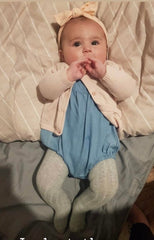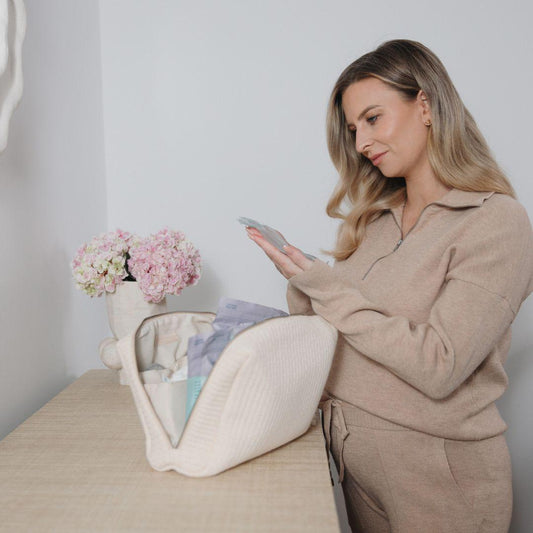Clubfoot or Congenital Talipes Equino Varus (CTEV) is a common addition that affects one or both feet of a newborn bub.
Harlie's Journey - By Mama Jess
At our 20 week scan, we were told our baby girl would be born with right bilateral talipes (clubfoot). My husband was born with clubfoot, but it still came as a massive shock as we have been told it isn't genetic. We were also told that we needed to have a further investigation done as it may be a sign of other developmental issues.
At 38 weeks, our healthy little girl Harlie was born. Her foot was quite severe but didn't cause her any pain. We were seen by a paediatrician a few hours after she was born, and they sent a referral to the Royal Children's Hospital.
When Harlie was two weeks old, we began her journey to correct her little curly foot. The RCHs hospital use a method called the ponsetti method to correct clubfeet. Harlie began receiving a full leg cast which was slowly stretching her foot back into the correct position.

This wasn't painful at all for her, just a bit uncomfortable. The cast was changed on a weekly basis, and a new position was formed. After two casts, the 1st lockdown happened, and all treatment was put on hold. During this time, it was hard to watch all the progress we had made slowly fade away, and her foot slowly start to curl back in. Once treatment resumed, Harlie received another nine casts to get her foot in the correct position to move to the next step in the treatment. The tenotomy. This is a small surgical procedure done under a local anaesthetic to release and lengthen her Achilles' tendon. Harlie then received another two casts to make sure her foot was perfect to go into the boots and bar.
The casting process was long and slow, and it felt like it was never going to end. When Harlie was in the cast, she wasn't able to be bathed, she couldn't do tummy time for long periods, and she always seemed uncomfortable with a big heavy cast on, but she was an absolute trooper through it all! It hasn't delayed any development for Harlie if anything it is pushing her to achieve more.
After what felt like a lifetime Harlie finally moved to the next stage, boots and bars.

The first week that Harlie was in the boots was hell! She wouldn't sleep; she was so unsettled and just miserable. Slowly as time went on, Harlie was able to wear the boots for long periods and became more adjusted to her new feet position. Harlie now wears her boots for 23 hours a day and is in a such a good routine she knows when they come off and go back on. After three months of Harlie wearing the boots for 23 hours a day, she will go down to 16 hours and eventually 12 hours overnight.
Harlie's foot has responded to treatment better than I could have ever imagined, and we are so happy with the treatment so far at the RCH. I can't wait to see how it will be in months to come!


Sloane's Journey - By Mama Annalise
My pregnancy with Sloane was my 'rainbow' pregnancy after a missed miscarriage. It was a very difficult pregnancy, and I was very sick all of the time
At our 20 weeks scan, we were told she had two' soft markers' of a syndrome, those being Unilateral Talipes of the right foot (Clubfoot) and Renal Pylectasis (enlarged left kidney). We were devastated and went through genetic counselling to determine if we wanted an amniocentesis at The Royal Women's Hospital.
After much research, we declined. Although these two markers were reasonably common, they were very uncommon to be seen together and more so in a female.
Sloane was born via planned caesarean at 38 weeks and six days. She was perfectly healthy, just with a Clubfoot - her kidney corrected itself soon after birth.

Sloane became a patient of our local Clubfoot clinic - she was first casted at 5.5 weeks old. The first afternoon and night after casting was an absolute nightmare. She screamed and screamed until she lost her little voice. My mum was here to help us, and all I could do was hold my baby as my husband, my baby and I all cried. She wasn't in pain, just discomfort.

Clubfoot requires a method of correction called The Ponseti Method. It is a series of corrective leg casts to gently manipulate the foot whilst still soft, into the correct position. Each cast got easier to deal with, and she became more accepting each time we had a cast change.
Sloane's foot was a more complex case of clubfoot and required more than the usual number of casts. She had five casts, and then a small tenotomy operation was performed. A tenotomy is where the doctor performs a small cut to the back of the ankle to releases a tendon in her foot to increase flexibility.
Although it was numbed, she had this done whilst awake, and when we came back into the room, she was screaming! It was awful. But she quickly recovered and slept through the whole night. She was back to herself the next morning. After a tenotomy, a child then goes into a leg cast for three weeks whilst the foot heals. Once the three weeks is up, children are placed into foot bracing called Boots and Bar bracing, or BNB for short. This was by far, the hardest part of our journey.

The six days after we moved to BNB bracing were absolute nightmares. She developed infected blisters from rubbing and subsequently went back into a leg cast for four weeks so she could heal. It was such a relief to be back in a cast! After those four weeks, we tried BNB bracing again. It was much better this time, and she tolerated them much more. It took us a month to get her to sleep in her bracing, as for three months children are required to wear the bracing 23 hours a day (1 hour off for bath time). After those initial three months, children then moved to 'nights and nap' wear, so basically, anytime they are asleep they are in the braces to overcorrect the foot to keep it facing the correct way.
The time in the bracing decreases only as sleep does. Sloane is now two years old and wears them for approximately 14.5 hours a day, which is her night time and nap time added together. Children with clubfoot will wear the bracing for sleep until 4 or 5 years old. Other side effects include having two different sized feet and one calf noticeably skinnier than the other. Clubfoot has not stopped Sloane from doing anything! She has smashed every single milestone, runs, jumps, climbs, does swimming and dancing! Nothing stops her, and nothing ever will!









